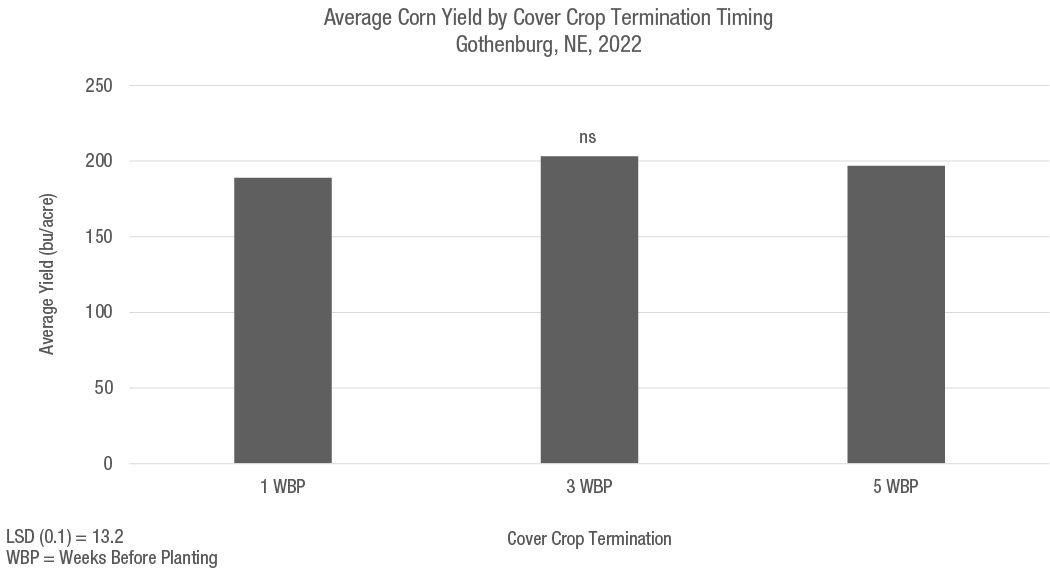The Effect of Cereal Rye Cover Crop Termination Timing on Irrigated Corn
February 13, 2023
TRIAL OBJECTIVE
- The use of cover crops in agriculture has many agronomic and economic benefits as well as challenges. Cover crops can help reduce wind and water erosion, mitigate soil compaction, and suppress weeds. However, cover crop termination timing with its effects on soil moisture, soil temperature, weed suppression, and other factors, is a challenge to consider when cover crops are incorporated into the rotation.
- The objective of this study was to evaluate how corn is influenced by cover crop termination timing.
RESEARCH SITE DETAILS
Location
Gothenburg, NE
Soil Type
Hord silt loam
Previous
Crop Soybean Tillage
Type No-till
Previous
Crop Soybean Tillage
Type No-till
Planting Date
05/11/22
Harvest Date
11/10/22
Potential Yield
(bu/acre) 250 Seeding Rate
(seeds/acre) 36,000
Potential Yield
(bu/acre) 250 Seeding Rate
(seeds/acre) 36,000
- The entire study area was drilled with a rye cover crop at 100 lb/acre on Oct 22, 2021.
- The study design was a split-plot with termination timing as the whole plot treatment and corn product as the subplot treatment with four replications.
- Corn products
- Two regular tall corn
- Good vigor (111 RM)
- Poor vigor (114 RM)
- One short statured corn (112 RM)*
- Two regular tall corn
- Cover crop termination timings
- 5 weeks before planting (WBP)
- 3 WBP
- 1 WBP
- Cover crop termination timings
- The cover crop was terminated with an application of Roundup PowerMAX® herbicide at 32 fl oz/acre.
- A composite soil sample per cover crop termination treatment was taken on April 27, 2022 (Table 1).
- A starter fertilizer application of 100 lb/acre N, 60 lb/acre P, 25 lb/acre S, 0.25 lb/acre Zn was applied across all treatments at planting. Additional N was sidedressed at the V6 growth stage at 50 lb/acre N using 360 Y-DROP® applicators on June 17, 2022.
- Corn was irrigated with a sub-surface drip system throughout the growing season.
- Normalized Difference Vegetation Index (NDVI) values were collected using a GreenSeeker® handheld crop sensor on June 28, 2022.
- Final stand counts and ear height were taken just prior to harvest.
- Plots were combine-harvested. Grain moisture content, test weight, and total weight were determined. Statistical analysis for Fisher’s LSD was performed.
Table 1. Soil test information.


UNDERSTANDING THE RESULTS
- There is a significant trend between NDVI values and cover crop termination timing. The earlier the burndown, the higher the NDVI recorded at the V8 growth stage, which indicates a larger quantity of healthy vegetation (Figure 1). The lowest NDVI values were recorded when the burndown treatment was applied 1 WBP (Figure 2), indicating that there was significantly less healthy tissue when the burndown treatment was applied closer to planting.
- Nutrient tie up and soil moisture depletion by cover crops prior to seeding can be challenging. Based on soil test information (Table 1), it is possible that some nitrogen (N) was tied up and not readily available for plots terminated 1 and 3 WBP as indicated by the lower soil nitrate levels for those treatments compared to the levels for the 5 weeks before planting treatment.
- No significant precipitation occurred two weeks after sidedressing (see weather data in research report book introduction), hindering the opportunity for the applied N to be absorbed by the corn plants, thus increasing the difference between treatments.

- Across all corn products, the highest numerical yields were obtained when terminating cover crop 3 or 5 WBP (Figure 3). However, the yield difference was not statistically significant. As NDVI data suggests (Figure 2), N tie up and soil moisture depletion at the beginning of the growing season might explain this yield trend.
- No significant difference was observed in yield when comparing different corn products (Figure 4) and their interactions with cover crop termination timing. Also, harvest stand count did not differ significantly between treatments (data not shown).


KEY LEARNINGS
- Although there was a yield trend favoring earlier cover crop termination timings, the difference was not statistically significant in this study.
- There was no significant effect of corn product on differences in average yield response across termination treatments in this study.
- NDVI readings at the V8 growth stage suggest less nitrogen availability (N tied up) at early vegetative stages when cover crops were terminated close to planting.
- Farmers should work with their local sales team member to help identify the best management practice for their production systems.
7817_182353
Seed Brands & Traits
Crop Protection
Disclaimer
Always read and follow pesticide label directions, insect resistance management requirements (where applicable), and grain marketing and all other stewardship practices.
©2024 Bayer Group. All rights reserved.